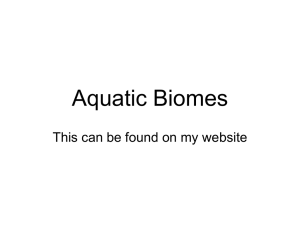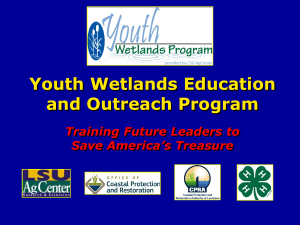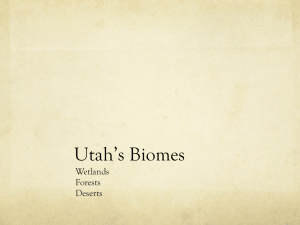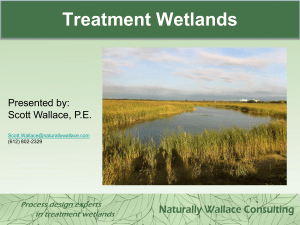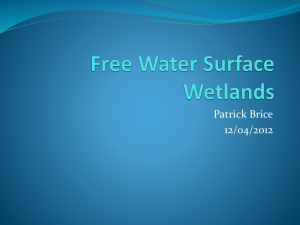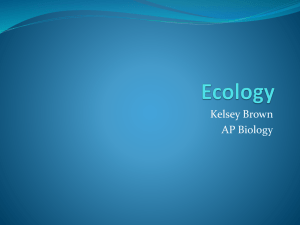ppt - Department of Environmental Sciences
advertisement
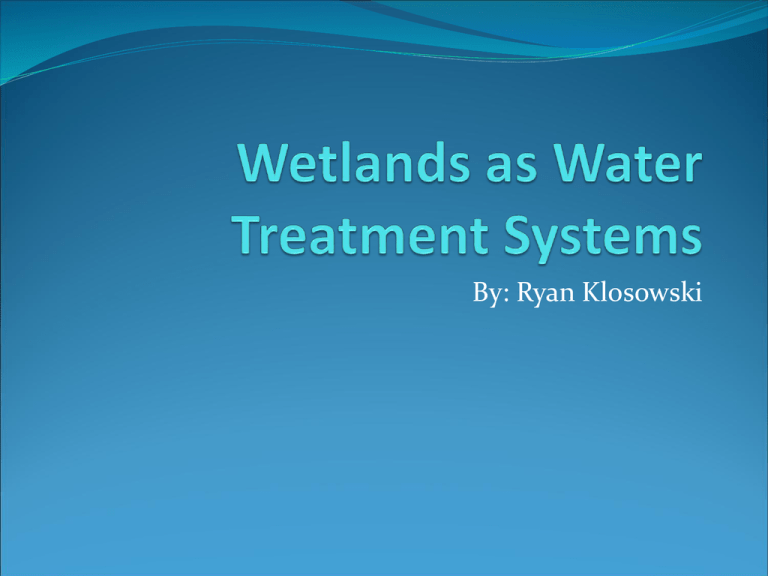
By: Ryan Klosowski Outline of Points Background of Wetlands Why Wetlands are needed/Problems How Wetlands are solutions? Case Study Showing Wetlands as a Solution Conclusions My conclusion Objective. The purpose of this presentation is to explain what a wetland is and to show how wetlands could be used as water treatment systems for nutrients and toxins. What is a Wetland? “An area where water is present at or near surface for a whole year or different times during the growing season” (US EPA) Hydric soils Hydrophitic vegetation http://www.al.nrcs.usda.gov/technical/ph oto/wet/veg/wetlands3.jpg Types of Wetlands Marshes- soft-stemmed plants Swamps-woody plants Bogs-freshwater/ often glacial lakes/sponge peat deposits/ moss and evergreens Fens-freshwater, grasses, shrubs, wildflowers http://www.maine.gov/dep/blw q/wetlands/inland.htm http:// water.e pa.gov/ type/we tlands/i mages/ bogvl.jp g http://www.cedarcreek.umn.edu/habitats/i mages/midsize/alderslab.jpg http://w ww.co.ke ndall.il.u s/forest_ preserve/ images/sf 3.jpg Number of Wetlands 6% of the earth’s land surface (Wetlands International) .01% of all water (Wetlands International) http://geochange.er.us gs.gov/sw/impacts/hy drology/wetlands/wet _usa2.jpeg http://www.wetlands.org/Portals/0/wetland%20invento ry/wetlands_map2.jpg Why Wetlands Are Needed/Problems Runoff from agricultural fields, sewer sludge causing algal blooms, and leading to problems down stream Pesticides and chemicals into water causing sickness and disease/contamination Leaching from landfills into groundwater Loss of Wetlands leading to more run off How Wetlands Are Solutions? Aquatic plants in wetlands and some microbes can take up the nitrogen and excess nutrients from run off Sediment that contains some of the heavy metals can settle out towards the bottom of the wetland out of the water. Volitization can occur causing dissolved solid toxins to be turned into gases which leave the system Decomposition by some microbes Case Study Tawain/Kaoping River Wetland constructed in 2004 Non-point pollution from sewage plant, agricultural fields, and industrial wastes into the river. Make more green areas, protect biodiversity http://cgcanal.cca.gov.tw/eng/images/dalian -a-1_clip_image014.jpg Kaoping River 3,625 km. http://eem.pcc.gov.tw/eemadm/files/images /Experiimage002234.img_assist_custom.jpg http://www.chinamaps.org/i mages/china-map/provincemaps/thumb/taiwan.jpg Study A paper mill B agricultural runoff 7 basins A6 and B7 conservation A2-A5 and B2-B6 treatment A1 and B1 inlets (Wu et el, 2010) Experiment Took water samples quarterly from inlets A1 and B1 and outlets of A1, A2, A3, A6, B1, B3, B4, and B7 grab method Flow rates at each point Refrigerated until used. Checked for suspended sediment, dissolved oxygen, total nitrogen, total phosphorus , conductivity , pH. Chlorophyll A and total chloroforms Ion Chromatography, Orion DO meter for oxygen, portable conductivity, and spectrometer (Wu et el, 2010) Results (Wu et el, 2010) Results •A. 13,454 m 3/day, 0.08 m/day, and 5.5 days •HLR, and HRT for System B (hydraulic retention rate, hydraulic retention time were •B. 5,309 m /day, 0.04 m/day, and 13.3 /day, •48% BOD and TC from A •96% from B •TN= 52 and 61% •TP=40% (Wu et el, 2010) Conclusions Lower BOD and Eh because of biodegradation Higher Dissolved Oxygen toward surface due to algae. Low oxygen in lower water because of nitrification and denitrification and lower nitrate and ammonia. Removed nitrogen the most BOD (biological oxygen demand) higher correlation with RR and effluent concentrations; higher BO loading, more removal and higher effluent. Conclusions No significant difference for PLR (pollutant loading rate) and RR of TN, as well a TP This might be because of plant removal of nutrients. Increase of nutrients if plants not harvested or sediment removal First order decay model k values of TN (Total Nitrogen) =.15 and .09; TP(Total Phosphorus)=.1 and .09p; BOD=.21 and .08 Water not meet requirements to be reused for irrigation 2 things to Increase Pollutant removal: Harvest plants frequently to keep plants with high metabolic rates for removal Decrease amount of nutrients before getting into the wetland. My Conclusions Wetlands are efficient of removing nutrients and toxins from, runoff and sewage sludge. More wetlands need constructed to be able to catch more runoff Less runoff into rivers could also be an important solution Wetlands not also important for pollutant removal but also biodiversity and wildlife preservation. Worked in Taiwan, can work here in the US What was Discussed? Background of Wetlands Why Wetlands are needed/Problems How Wetlands are solutions? Case Study Showing Wetlands as a Solution Conclusions My conclusion References Wu, C. Y., Kao, C. M., Lin, C. E., Chen, C. W., & Lai, Y. C. (2010). Using a constructed wetland for non-point source pollution control and river water quality purification: a case study in Taiwan. Water Science & Technology, 61(10), 2549-2555. US EPA. 2001. Functions and Values of Wetlands. US Environmental Protection Agency. Online. 12 November 2011. < http://water.epa.gov/type/wetlands/outreach/upload/fun_val.pdf/>. Washington State Department of Ecology. 2011. Functions and Values of Wetlands. Washington State Ecology Department. 11 November 2011. <http://www.ecy.wa.gov/programs/sea/wetlands/functions.html>. Wetlands International. 2011. What Are Wetlands? Wetlands for Water and Life. 9 November 2011. http://www.wetlands.org/Aboutus/Whatarewetlands/tabid/202/Defau lt.aspx>. Gold, J Mike. 2011. Celebrate the Wetlands. Mike J. Gold’s Blog. 13 November 2011. <http://blog.mikejgold.com/celebrate-the-wetlands>. Questions?


